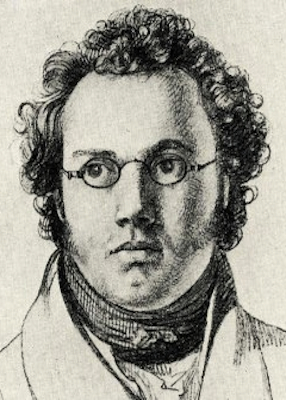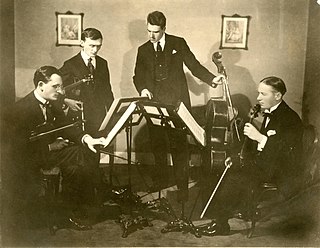
The term string quartet can refer to either a type of musical composition or a group of four people who play them. Many composers from the mid-18th century onwards wrote string quartets. The associated musical ensemble consists of two violinists, a violist, and a cellist. Even though a string quartet consists of two violins, a viola and cello, the double bass is almost never used in the ensemble mainly because it would sound too loud and heavy.

Chamber music is a form of classical music that is composed for a small group of instruments—traditionally a group that could fit in a palace chamber or a large room. Most broadly, it includes any art music that is performed by a small number of performers, with one performer to a part. However, by convention, it usually does not include solo instrument performances.
Sonata form is a musical structure generally consisting of three main sections: an exposition, a development, and a recapitulation. It has been used widely since the middle of the 18th century.

A string quintet is a musical composition for five string players. As an extension to the string quartet, a string quintet includes a fifth string instrument, usually a second viola or a second cello, or occasionally a double bass.
The Takács Quartet is a string quartet founded in Budapest, Hungary, and now based in Boulder, Colorado, United States.

The Trout Quintet (Forellenquintett) is the popular name for the Piano Quintet in A major, D. 667, by Franz Schubert. The piano quintet was composed in 1819, when he was 22 years old; it was not published, however, until 1829, a year after his death.

The Piano Quintet in E-flat major, Op. 44, by Robert Schumann was composed in 1842 and received its first public performance the following year. Noted for its "extroverted, exuberant" character, Schumann's piano quintet is considered one of his finest compositions and a major work of nineteenth-century chamber music. Composed for piano and string quartet, the work revolutionized the instrumentation and musical character of the piano quintet and established it as a quintessentially Romantic genre.
The Piano Quintet in F minor, Op. 34, by Johannes Brahms was completed during the summer of 1864 and published in 1865. It was dedicated to Her Royal Highness Princess Anna of Hesse. As with most piano quintets composed after Robert Schumann's Piano Quintet (1842), it is written for piano and string quartet.
The String Quartet No. 15 in G major, D. 887, was the last quartet written by Franz Schubert in June 1826. It was posthumously published in 1851, as Op. 161. The work focuses on lyrical ideas and explores far-reaching major and minor modes, which was uncommon to this degree in his compositions. Schubert reinforced this with a range of dynamic contrast and use of texture and pizzicato. The structural form of the movements in this quartet are somewhat ambiguous due to Schubert's focus on lyricism rather than traditional harmonic structure.

Franz Schubert's final chamber work, the String Quintet in C major is sometimes called the "Cello Quintet" because it is scored for a standard string quartet plus an extra cello instead of the extra viola which is more usual in conventional string quintets. It was composed in 1828 and completed just two months before the composer's death. The first public performance of the piece did not occur until 1850, and publication occurred three years later in 1853. Schubert's only full-fledged string quintet, it has been praised as "sublime" or "extraordinary" and as possessing "bottomless pathos," and is generally regarded as Schubert's finest chamber work as well as one of the greatest compositions in all chamber music.
The Hollywood String Quartet (HSQ) was an American string quartet founded by violinist/conductor Felix Slatkin and his wife cellist Eleanor Aller. The Hollywood String Quartet is considered to be the first American-born and trained classical music chamber group to make an international impact, mainly through its landmark recordings. These recordings have long been regarded as among the most outstanding recorded performances of the string quartet repertoire.
The String Quintet No. 4 in G minor, K. 516, written by Wolfgang Amadeus Mozart, is like all of Mozart's string quintets a "viola quintet" in that it is scored for string quartet and an extra viola . The mood of the piece is dark and melancholic, typical of Mozart's G minor works.
The String Quintet No. 1 in B flat major, K. 174, was written by Wolfgang Amadeus Mozart in December 1773. Unlike Mozart's other viola quintets, which are scored for two violins, two violas and cello, this early work is scored for two violins, two violas and basso. It is inspired by Michael Haydn viola quintets in C major and G major, written earlier in the same year.
The String Quintet No. 2 in C minor, K. 406/516b, was written by Wolfgang Amadeus Mozart in 1787. Like all of Mozart's string quintets, it is a "viola quintet" in that it is scored for string quartet and an extra viola. Unlike his other string quintets, however, the work was not originally written for strings. Having completed the two string quintets K. 515 and K. 516, Mozart created a third by arranging his Serenade No. 12 for Winds in C minor K. 388/384a, written in 1782 or 1783 as a string quintet. Although by then Mozart was entering each new work into his catalogue of compositions, he did not enter this quintet, perhaps because it was an arrangement rather than a new work.

The London String Quartet was a string quartet founded in London in 1908 which remained one of the leading English chamber groups into the 1930s, and made several well-known recordings.
The Léner String Quartet, sometimes written the Lehner String Quartet, was a string quartet of Hungarian origin, founded in Budapest in 1918, which for most of its pre-war career operated in or from London. They appeared at the Royal Albert Hall, London on three occasions between 1922 and 1926. They also performed in New York, Amsterdam, and elsewhere in Europe. The Léner made the first complete recorded cycle of Beethoven quartets.
The Spencer Dyke Quartet was a string quartet active in England through the 1920s. It was formed in 1918 and its personnel remained unchanged until August 1927 when Bernard Shore became the violist and Tate Gilder the second violin. It is best remembered now for a series of pioneering chamber music recordings made for the National Gramophonic Society. At the time of the recordings, the Quartet members were Edwin Spencer Dyke, Edwin Quaife, Ernest Tomlinson (viola) and Bertie Patterson Parker cello. Bernard Shore played viola in the last two recordings only.
The Melos Ensemble is a group of musicians who started in 1950 in London to play chamber music in mixed instrumentation of string instruments, wind instruments and others. Benjamin Britten composed the chamber music for his War Requiem for the Melos Ensemble and conducted the group in the first performance in Coventry.

The Piano Quartets, WoO 36, by Ludwig van Beethoven are a set of three piano quartets, completed in 1785 when the composer was aged 14. They are scored for piano, violin, viola and cello. He composed a quartet in C major, another in E-flat major, and a third in D major. They were first published posthumously in 1828, however numbered in a different order: Piano Quartet No. 1 in E-flat major, Piano Quartet No. 2 in D major, and Piano Quartet No. 3 in C major.
The Doric String Quartet is a string quartet based in the UK. It was formed in 1998. As of 2023, the members are Alex Redington and Ying Xue on violin, Hélène Clément on viola and John Myerscough on cello. Past members include Jonathan Stone, Simon Tandree and Chris Brown. In 2008, the quartet won first prize at the Osaka International Chamber Music Competition and second prize at the "Premio Paolo Borciani" International String Quartet Competition.
 in C major
in C major






